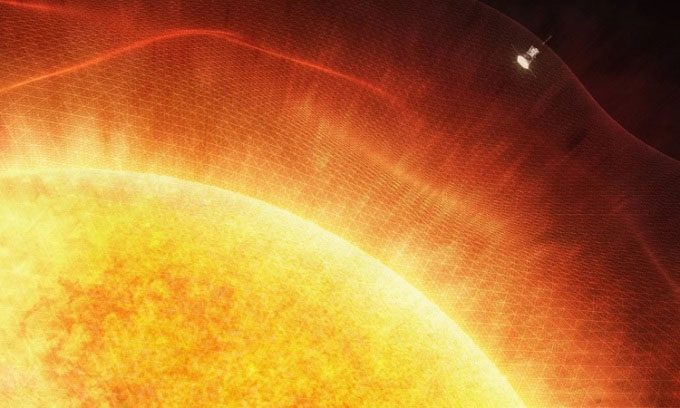The extreme temperature difference between the outer layer of the atmosphere and the surface of the Sun has been a long-standing puzzle for astronomers.
Very few places in the Solar System are hotter than the surface of the central star. However, the thin twisted plasma strands in the outer layer of the Sun’s atmosphere, known as the corona, are much hotter than the surface, according to space scientist Jia Huang from the University of California, Berkeley. The surface of the Sun has a temperature of about 5,500 degrees Celsius, while the corona can reach temperatures of up to 1.1 million degrees Celsius. This discrepancy is referred to as the coronal heating problem, and astronomers have been attempting to explain it since the mid-19th century, as noted by Popular Science.

NASA’s Parker Solar Probe flying through the corona and sampling particles in 2021. (Photo: NASA).
According to Huang, solving this issue could help researchers gain a better understanding of the Sun. Solar physics is crucial for predicting space weather to protect humanity. Moreover, the Sun is the only star that humans can send probes to, allowing for a better understanding of other stars in the universe.
During the total solar eclipse of 1869, when the Sun, Moon, and Earth aligned, scientists were able to observe the faint corona. Their observations revealed a feature in the corona, believed to be evidence of the existence of a new element called coronium. A new hypothesis based on quantum mechanics developed over 60 years later revealed that the “new element” was actually iron heated to a temperature higher than that of the Sun’s surface.
This new explanation for the 1869 measurement is the first evidence of the extreme temperature of the corona, driving decades of research aimed at understanding why plasma can be so hot and where the energy in the corona comes from. “We are certain that the problem is still unresolved, even though we have many hypotheses and the entire astronomy community is actively searching for explanations,” Huang shared. Currently, there are two main hypotheses regarding how energy from the Sun heats the corona: wave motion and a phenomenon known as nanoflares.
The surface of the Sun is turbulent, akin to a pot of boiling water. Due to convective plasma, it generates extremely strong magnetic fields. These magnetic fields can shift and ripple in a special wave-like pattern known as Alfvén waves, pushing protons and electrons upward from the Sun’s surface. Astronomers believe that the charged particles disturbed by Alfvén waves may transfer energy into the corona, heating it to incredible temperatures.
Another explanation is that when the Sun’s plasma collapses and circulates in the upper atmosphere, it twists the magnetic field lines into a knot-like shape. Eventually, these magnetic field lines can no longer withstand the pressure. When twisted too much, the magnetic lines snap back in an explosive event known as magnetic reconnection, causing charged particles to fly around and heat up. This nanoflare phenomenon adds energy to the corona. Astronomers have observed several examples of nanoflares using modern telescopes and satellites.
Researchers still do not know how frequently Alfvén waves or nanoflares occur. The Parker Solar Probe, launched in 2018, is set to fly closer to the Sun than any previous spacecraft. It is currently traversing some regions outside the corona, providing the first close-up images of the movements of particles that may be responsible for the extremely high temperatures of this layer.


















































